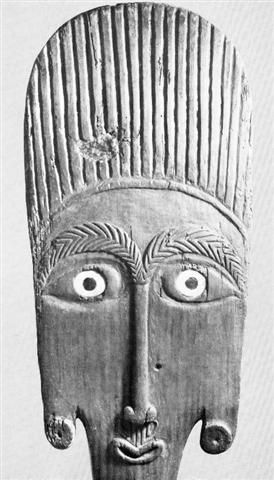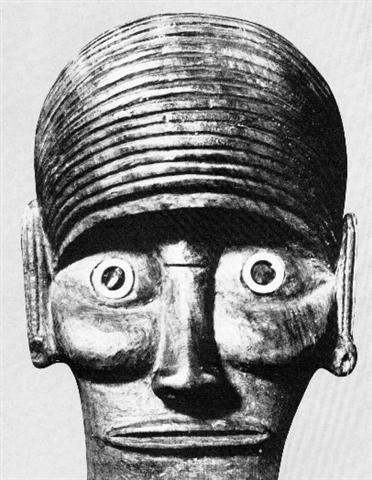4. The long nose in the ao face has the appearance of a tree:
This tree is located at summer solstice, and the 'tree' in the ua face should be the same tree at winter solstice. It is (in a way) the tree which grew from the heart of Ulu: ... His wife sang a dirge of lament, but did precisely as she was told, and in the morning she found her house surrounded by a perfect thicket of vegetation. 'Before the door,' we are told in Thomas Thrum's rendition of the legend, 'on the very spot where she had buried her husband's heart, there grew a stately tree covered over with broad, green leaves dripping with dew and shining in the early sunlight, while on the grass lay the ripe, round fruit, where it had fallen from the branches above. And this tree she called Ulu (breadfruit) in honor of her husband ... It is also (in a way) the tree in which the head of One Hunaphu was placed: ... And they were sacrificed and buried. They were buried at the Place of Ball Game Sacrifice, as it is called. The head of One Hunaphu was cut off; only his body was buried with his younger brother. 'Put his head in the fork of the tree that stands by the road', said One and Seven Death. And when his head was put in the fork of the tree, the tree bore fruit. It would not have had any fruit, had not the head of One Hunaphu been put in the fork of the tree. This is the calabash, as we call it today, or 'the skull of One Hunaphu', as it is said. And then One and Seven Death were amazed at the fruit of the tree. The fruit grows out everywhere, and it isn't clear where the head of One Hunaphu is; now it looks just the way the calabashes look. All the Xibalbans see this, when they come to look ... It is the coconut tree, and all sorts of fruitful mythic trees. They represent the vertical 'cosmic tree' which keeps the sky dome up. Probably it is seen as the middle of hua poporo.
We say south 'pole' and north 'pole' and mean this 'tree'. On Easter Island, when sun stands low, the 'face' is compressed like the face on the ua staff. In the beginning sky was lying directly on the surface of the earth and it was totally black in between. Tane (the god of trees) managed to raise the sky and let in the light: ... Sky (rangi) and Earth (papa) lay in primal embrace, and in the cramped, dark space between them procreated and gave birth to the gods such as Tane, Rongo and Tu. Just as children fought sleep in the stifling darkness of a hare paenga, the gods grew restless between their parents and longed for light and air. The herculean achievement of forcing Sky to separate from Earth was variously performed by Tane in New Zealand and the Society Islands, by Tonofiti in the Marquesas and by Ru (Tu) in Cook Islands. After the sky was raised high above the earth, props or poles were erected between them and light entered, dispelling the darkness and bringing renewed life ... Ure Honu (who had found the skull of the sun king - helped by a rat, the kuhane of Hotu Matua) later lost it and searched inside the 'house' of king Tuu Ko Ihu. The house is a symbol for the dome of the sky and the roof needs props (tree stems), otherwise it will be completely dark inside. |


